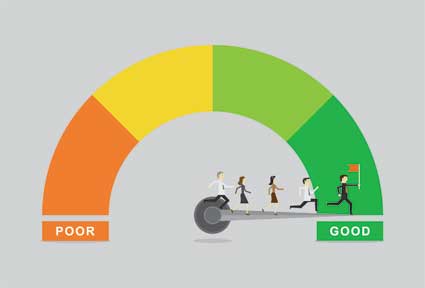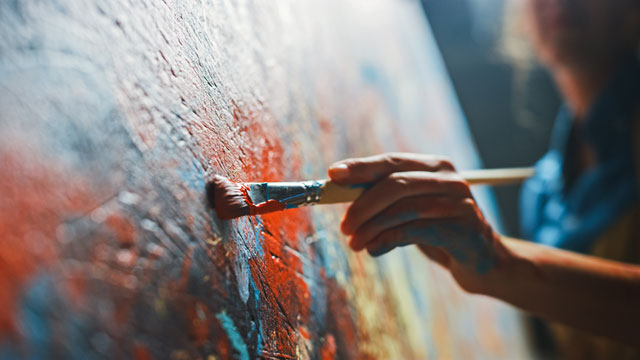Proper hygiene in the bathroom is extremely important. While bacteria are of course a concern, you must also consider mold in the bathroom, as mold tends to grow in warm, moist environments. Always use separate cleaning cloths and gloves in the bathroom so there is no chance that they will come into contact with any other surface in a different room. These cloths should be washed and dried after each individual use, and never leave a damp cloth in the bathroom, as this will become a breeding ground for bacteria.
The best cloths for bathroom use are cloths that are 100% cotton. You want the cloths to be as absorbent as possible. Avoid using cloths with heavily embroidered designs, which are not as effective in drying surfaces. As a general rule of thumb, new towels should always be washed before their first use. New towels tend to have fluff and some loose cotton, which tend to reduce their absorbency.
Before we discuss cleaning elements of the bathroom, a note about ventilation is important. High humidity tends to create an environment in which mold can develop. Some types of mold can be extremely dangerous, and especially for people with allergies or asthma. After bathing or showering, open the window or turn on the fan to clear the steam from the room. You should leave the window open or run the fan for several minutes to remove as much moisture from the room as possible.
Anything that remains wet in the bathroom is a potential area for mold to grow in. If you have children, be sure to dry all toys after use. If you ever do find mold developing, use a spray bottle filled with water with a few drops of chlorine bleach added to it. Spray the bleach solution onto the mold and let it evaporate. You might need to repeat this process one or two times, but this solution could kill the mold and prevent it from spreading.
Cleaning the Toilet
Good toilet hygiene is essential because bacteria are very easily transferred from one person to the next, but not just from the toilet seat. The flush handle is also a common area on which to find bacteria. If there are several people using the same toilet, it should be disinfected daily and scrubbed weekly. We will now discuss how to do these tasks quickly and effectively.
It's important not only to clean the toilet bowl, but under the rim too. It is not recommended to use a toilet brush. Toilet brushes are notoriously bad at attracting bacteria and harboring germs. Put on a pair of rubber gloves (gloves that are assigned to the bathroom only) and scrub the porcelain clean. Sprinkle some scouring powder or a household disinfectant (such as chlorine bleach) into the bowl and let it soak in for a few minutes. You can make your own natural scouring powder by combining some borax and baking soda. One handy trick is to use an old toothbrush to scrub the bottom of the rim.
To remove lime scale or hard-water deposits in the toilet bowl, pour some white vinegar into the bowl and scrub the affected areas. Let the vinegar soak for a few minutes before flushing.
Be sure to disinfect the seat and the flush handle. Wash both with some warm, soapy water. Then, disinfect them by spraying a diluted bleach solution and wiping them dry.
Another tip for keeping your toilet stain-free is using denture-cleaning tablets. Drop a few tablets in the water and leave overnight. A can of cola, poured into the bowl and left for about an hour, also helps to reduce stains.
Cleaning the Bathtub
It is so much easier to quickly clean and dry the bathtub after each use than it is to scrub it after a long period of use. Never use anything abrasive on the bathtub surface, as it will scratch easily.
To remove stains from an enamel bathtub, make a paste by mixing baking soda with a few drops of water and rub it on the surface. To remove rust stains on the bathtub fixtures, rub the fixture with some salt and lemon juice, then rinse. If a bathtub is very dirty, the best approach is to fill the tub with warm water and add a few scoops of clothes-washing detergent, and let it soak overnight.
Cleaning the Shower
A shower typically uses less water than a bathtub. The shower enclosure is usually made of glass, which is easier to keep clean than enamel. A white sealant is usually used to prevent water from leaking out of the shower, and mold does tend to collect on these surfaces over time since they are often kept wet. Use your spray bottle filled with the water/chlorine bleach mixture to spray the areas at least once per month. It will help keep mold and mildew at bay.
One of the best ways to keep the shower clean is to use a squeegee after each use. A squeegee is the device most people use to clean the windshields on their cars. A squeegee will remove the excess water and moisture, which will make cleaning easier. You can also remove soap scum deposits by spraying surfaces with a mixture of half water and half white vinegar.
Tile grout lines are absorbent and tend to hold onto soap scum. Use an old toothbrush to gently scrub the grout lines with a homemade scouring powder, with a few drops of bleach or white vinegar.
Cleaning Shower Curtains
Try to use a nylon shower curtain – you can easily remove it and put it in the washing machine. If the curtain cannot be placed into the washing machine, soak it in a solution of water and a few drops of chlorine bleach.
Bathroom Sinks
Clean an enamel bathroom sink with warm, soapy water. To remove any water stains on the fixtures, use an old toothbrush and scrub on a mixture of water and white vinegar. For particularly tough stains, dip a cloth into the vinegar mixture and wrap the cloth around the fixture and leave it for several hours.
Mirrors
Bathroom mirrors tend to show splashes and water stains. You should avoid wiping them when they are misted as this might encourage smears. There is no need to use chemicals to clean mirrors. One of the best glass cleaners is a mixture of half water and half white vinegar. Spray the mixture on a dry mirror, and wipe clean with a dry, clean cloth.
Floors
Cleaning the Living Room
For many people, the living room is where you relax after a long day. It should be as inviting as possible, and that begins with keeping it clutter-free. Your daily routine should always include tidying up the house, and especially the living room. Put movies, remote controls, magazines, and other objects in their proper place.
The living room is often the room that people use to judge if a house is clean. It is often the first room in the house that people enter when being invited inside. Fortunately, the living room is one of the easiest rooms to keep clean. There are three basic responsibilities: tidying, dusting, and vacuuming.
One of the reasons you want to tidy the living room every day is because clutter tends to build very easily in the living room. Make it second nature that everything gets put away in the living room before retiring for the evening.
Fresh air is essential to keeping a relaxing living room. Open the windows each morning and leave them open for at least the amount of time it takes you to get ready to leave the house. Fresh air helps to remove odors.
Dusting
Computers and TV screens tend to attract a great deal of dust. Wipe them with a fabric softener sheet to reduce the static charge. Then, use a damp cloth to dust fully.
To reduce the need to dust objects, consider placing any collections that you have behind glass, such as in a china closet. Anything that remains out on a surface will eventually need to be dusted.
Lampshades quickly show dust. A very slightly damp cloth is good for lampshades, although using the attachment on your vacuum cleaner will often work best for dust that accumulates on lamps and lampshades.
Vacuuming Rugs and Carpets
Removing dust from carpets and rugs is especially important for people with allergies. We will discuss cleaning tips for people with allergies in more detail in a later chapter. A vacuum cleaner with a HEPA filter is best and has the highest performance rating for retaining dust in its bag.
You should vacuum high-traffic areas at least a few times a week, although most living rooms will stay clean with a vacuum once per week. Accumulated dirt in the carpet actually tends to destroy a carpet over its lifetime. Particles of sand rub against the fibers, which causes the fibers to be cut.
At least once per month, you should move your furniture to vacuum under the furniture. This is especially true in households of people who are sensitive to dust or have dust allergies.
Vacuum Attachments
Your vacuum's attachments make dusting certain areas so much easier. You can use it to reach pictures hanging on the walls, or even hard-to-vacuum corners on the floor. You can use the brush attachment to gently dust the vents in electrical equipment, and any other area that would be impossible to reach with the vacuum.
Cleaning blinds is so much easier using the upholstery attachment. Dust particles settle onto the blinds and this dust is often difficult and tedious to remove with cloths. The upholstery attachment can also, of course, be used to dust the insides of your couch, chairs, and other upholstery in your living room. If you do this weekly, you will dramatically extend the life of your upholstery.
Empty the vacuum cleaner frequently to keep it working efficiently. Dispose of vacuum bags carefully, making sure not to release dust into the air when you replace them.
Cleaning a Fireplace
Always rake ash out of your fireplace before starting a new fire. This will make cleaning your fireplace simpler, and it will reduce the amount of dust that accumulates in your house. You can keep dust to a minimum by misting some of the ashes (when they are completely cold) with a little water. This will keep the dust from becoming airborne. Soot deposits can be scrubbed with water from the brickwork, but you might also be able to purchase chemical-free, non-toxic cleaners specifically used fireplaces. Your chimney should be professionally swept at least once per year as accumulated soot can sometimes cause chimney fires.
Cleaning Painted Walls
Paint is the easiest wall covering to clean and it is often the most durable. Before you attempt to wash a wall, always dust it using an attachment on your vacuum cleaner. If you do not remove the dust, the dust will blacken the water and ultimately make your walls even dirtier.
A mild solution of warm, soapy water will work best to clean walls, but if you have any grease build-up, a mild solution of washing soda and water will work best.
Always start at the bottom of the wall and work upwards. Use a dampened cloth or sponge, taking care not to rub the surface hard. Finish by dabbing the walls with dry paper towels to remove as much of the moisture as possible.
Cleaning Wallpaper
Wallpaper can be vacuumed with your vacuum attachment. Some wallpaper is washable, although some heavily textured papers are not as easy to clean. A barely damp cloth will be safe to use on most wallpaper, but try to clean an inconspicuous area first to see how it reacts to the cloth.
Cleaning Wood Walls or Paneling
Wood paneling does not require too much upkeep. Dust wood walls weekly with a damp cloth. A pencil eraser can be used to remove scuff marks or to remove stubborn stains.
Curtains and Blinds
Most curtains can be vacuumed with the vacuum attachment. Close the curtains and vacuum, making sure to capture dust in the folds of the fabric. Some curtains can be washed in the washing machine, but be sure to vacuum them first before putting them in the wash. For particularly dirty curtains, soak the curtains for a few hours in warm, soapy water with a mild detergent.
If there isn't a cleaning label on the curtains, it is probably best to have your curtains professionally dry-cleaned.



























